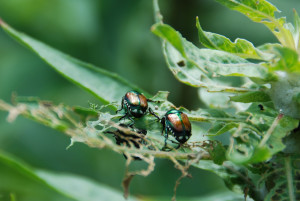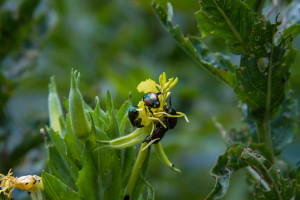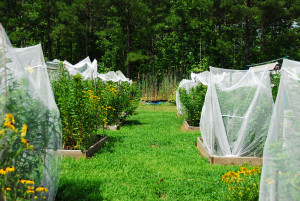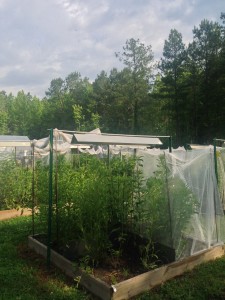By Joe Dawson, science writing intern

Japanese beetles make a meal of evening primrose leaves (Credit: Dejeanne Doublet/SERC)
Plants can seem pretty boring. They just sit there, after all. Sure, they can be pretty; they can make us sneeze. But what else do they do? A lot, it turns out. They are able to shift their own water and energy resources from leaves to stems to roots and back, grow tall or stay low and bushy, defend themselves through biological warfare, or warn their neighbors of danger. When doors get blocked, plants have ingenious ways of sneaking out through windows.
What, then, will plants do when humans spread a carbon dioxide blanket over the planet, warming it by burning fossil fuels? Research scientist Nate Lemoine of Colorado State University, with John Parker of the Smithsonian Environmental Research Center (SERC) and others, decided to investigate one such relationship with an experiment on the SERC campus in 2013 and 2014.

The beetles in this experiment did extensive damage to leaves and flowers, on average consuming a third of the foliage on every plant. (Credit: Dejeanne Doublet/SERC)
The goal: See how herbivores affect plants at modern-day temperatures, then see if heating the whole system up to future temperatures (approximating the projected climates of the year 2100) makes any difference. For this study, the researchers investigated how climate change could transform the relationship between the evening primrose, Oenothera biennis, and one of its main insect herbivores, the Japanese beetle, Popillia japonica. Lemoine and his collaborators grew plants with and without beetles, at both normal and elevated temperatures. Beyond the relationship between these specific plants and insects, it highlights the need to explore the complicated relationships between living things and how climate change will affect their interactions.
For this particular plant, the results, published in the July 2017 issue of Ecology, were surprising. In most ecology circles, it’s commonly thought the pressure of ravenous herbivores is a dominant force shaping how plants spend their resources. But for the evening primrose, warming may have trumped that.

Evening primrose plants, growing with and without nets. The nets prevent Japanese beetles from eating the plants in certain plots. (Credit: Dejeanne Doublet/SERC)
It appears that the warmth dried out the soil underneath the plants, and, whether beetles were eating them or not, plants had to act to defend themselves first and foremost against this water stress. At elevated temperatures, all the plants deployed a strategy of producing lots of smaller seeds. This strategy increases the chances that one of the seeds will germinate and survive, but decreases the chances of any single seed surviving or growing into a particularly healthy plant. In times of severe stress, the goal is simple survival.
“It wasn’t something I planned for or thought much about beforehand, but it turned out to be, as far as I can tell, what happened,” said Lemoine.
The fact that water stress impacted the plants has major implications for the planet. According to Lemoine, the Earth will be seeing a lot more water stress in the decades and centuries to come.
“Reduced soil moisture in the face of higher temperatures is one of the most consistent effects that we see. And it’s one of the most predictable,” Lemoine said. Climate predictors are uncertain about the extent of temperature increases, he added, but every tested scenario results in lower moisture in the soil.

Primrose plants shown with infrared heaters used to simulate a warmed climate. (Credit: Dejeanne Doublet/SERC)
While rising temperatures and drier soils are almost certainly on the menu, their extent and their effects are unknown. Studies on warming and plants, or warming and insects, have been going on for decades. But the kinds of experiments that deal with multiple factors (heat, herbivores, and plants all in one, for example) have been scarce. Co-author and SERC principal investigator John Parker has made a career studying the interconnectedness of ecosystems:
“Ecology is kind of like a cooking recipe in some ways,” said Parker. “You utilize particular ingredients and cook it at a certain temperature, and you more or less know what the end product will look like,” he said. “But you start warming things up and altering the ingredients with introduced species and biodiversity loss, and it really influences a lot of different things.”
Do you know what your front yard will look like in fifty years? Should you start planting succulents and replace your Kentucky bluegrass lawn with Arizonan gravel? Humans are changing the distribution of living things throughout the world and warming the planet. If we’re going to have any chance of maintaining a natural world the way it looks now, we need to study these systems comprehensively.
“We really need the full story,” said Lemoine.
With scientists like him, we may get a chance to hear it.

